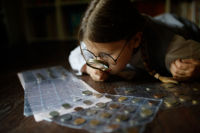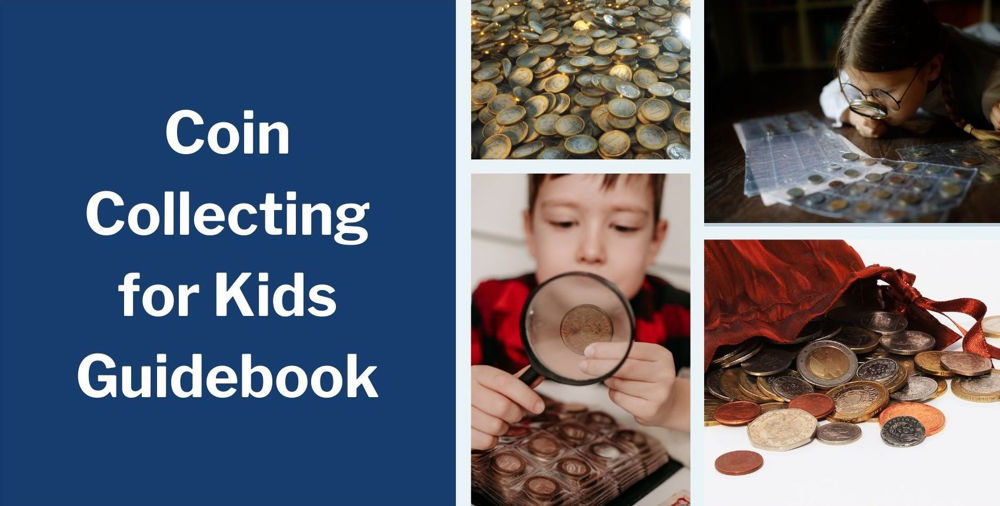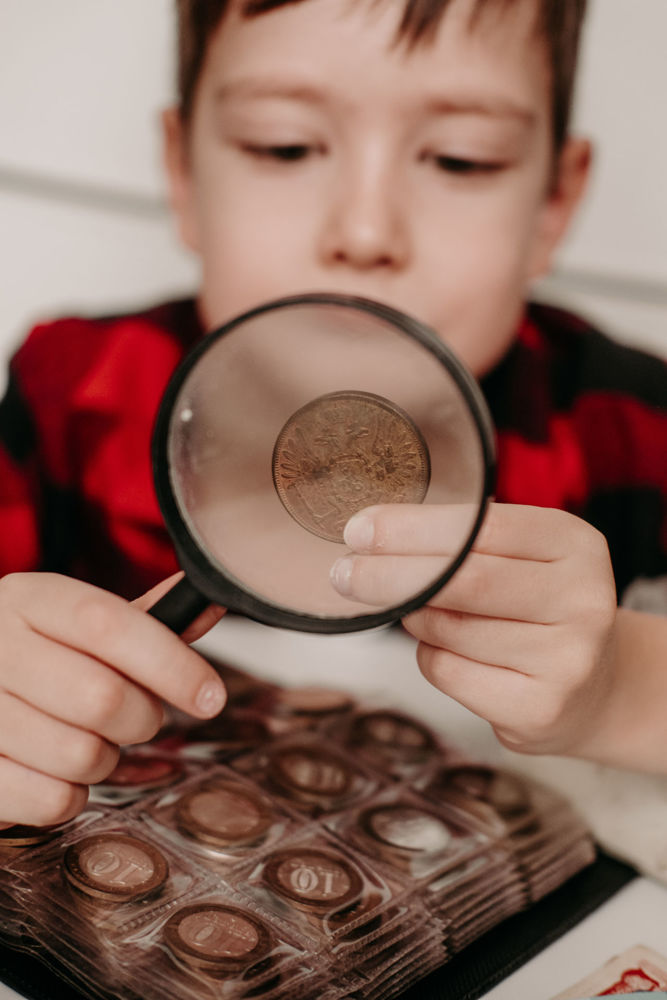Posted on June 16, 2021


Whether it's collecting state quarters, mint sets, ancient coins, or anything in between, coin collecting is a great hobby for kids. Not only is collecting a fun activity, but it is also an investment for the future. Children can learn about responsibility, finance, attention to detail, and history, all from this wonderful hobby. And with so much to learn about coin collecting, this is one lifelong activity that could stick with a young collector throughout the years.
On this page, we will let you know everything you need to know about coin collecting for kids, how to get started and resources for your collecting journey.
Table of Contents
Parents looking to share interests with their kids need to look no further than the coins already in their pockets. Coin collecting is an accessible and exciting hobby for children and their parents to share, building memories (and collections) that will last a lifetime. The younger a child starts collecting, the more excited they will be to collect alongside their parents and will likely continue to do so long after picture books, and stuffed animals are set aside.
Coin collecting is a hobby that rewards an early commitment. Some coin collectors we know start “helping” their children get started from the day they’re born. We recommend not starting a collection with a child who might be inclined to try to eat it.
Coin collecting isn’t just fun for hobbyists. It’s a great educational tool. Every coin tells its own story and has a history related to its minting and circulation. Since governments make coins, they tend to have as much symbolism as possible packed into each design.
 Coin collecting is an interactive way for kids to get hands-on learning in a variety of academic areas, including:
Coin collecting is an interactive way for kids to get hands-on learning in a variety of academic areas, including:
And there are non-academic skills coin collecting enhances as well:
Shared hobbies are one of the best ways for kids to make new friends. There are plenty of groups for kids to expand their coin collecting even further (more on these groups later). Just like adults, kids can get involved in collectors clubs and events specifically catered toward coin collecting. Some groups like the Boy Scouts have their own badges for collectors as well.
For all of the joy that comes with coin collecting, getting started young may be a wise financial decision. Many coins appreciate in value over time and can be sold for a profit in the future. Unlike other hobbies, which cost parents and children lots of money with zero return on investment, coin collecting can have a respectable financial payoff years down the road.
There are a wide variety of different coin types to choose from:
There is nothing more fun than discovering a new coin to add to your collection. There are plenty of opportunities to find new coins at events, trade with friends, buy directly from national mints, or browse at reputable dealers online.
Surprising your kids with new coins can help keep collecting fresh and exciting.
 Aside from collecting coins themselves, caring for a coin collection is another aspect of collecting that is something to teach children. After coins are found or bought, they need to be cared for and maintained. Kids learn how to properly handle coins, inspect them, and clean coins without damaging them. Who knows, this type of responsibility could be an excellent precursor to taking care of a new pet.
Aside from collecting coins themselves, caring for a coin collection is another aspect of collecting that is something to teach children. After coins are found or bought, they need to be cared for and maintained. Kids learn how to properly handle coins, inspect them, and clean coins without damaging them. Who knows, this type of responsibility could be an excellent precursor to taking care of a new pet.
Coins are best handled with gloves so as not to be damaged by any oils present on bare skin. And when it comes to coin cleaning, it’s best not to use heavy-duty cleaning supplies. Instead, opt for a solution of lemon juice (or vinegar) and water to maintain the shiny luster of coins without damaging them.
Check out the US Mint’s kids page on Caring for Your Coin Collection for more info.
If you don’t store coins properly, they lose their luster and may even get damaged. Therefore, coin storage is an essential aspect of coin collecting to ensure the value and longevity of any collection. Fortunately, coin storage is also relatively easy. Keep in mind these storage tips you can teach your kids:
One of the most fun things for kids to do is track their coin collection value. This can also prove to be a lesson in both finance and investing. It possibly helps with entrepreneurship, too, teaching kids how coins can appreciate in value and when to sell them at a profit.
When determining the value of a coin, keep in mind its grade (more on coin grading later) and exact minting. While some coins look the same, they could have completely different values just based on when they were minted.
It may not be easy, but completing coin sets will give your child a real sense of accomplishment. A fun and affordable set to start off with is the 2010 United States Mint America the Beautiful Quarters Program which depicts the 50-states of America. Sets like these will give your kids something to work toward and build upon over the years.
 First things first. Let’s find some coins for sale. Of course, you can go out with a metal detector and search for coins at the beach, but buying coins is the only way to determine your kids start with a good, solid collection to learn and build from.
First things first. Let’s find some coins for sale. Of course, you can go out with a metal detector and search for coins at the beach, but buying coins is the only way to determine your kids start with a good, solid collection to learn and build from.
When looking to buy coins, make sure to use only reputable dealers or qualified mints to ensure you are getting authentic coins. Look for dealers with positive online reviews and excellent Better Business Bureau ratings. Coins should come with some guarantee or documentation of their authenticity. You can always purchase quality coins from BullionMax or any other reputable dealer. There are also some coins to be purchased directly from the US Mint and other mints around the world.
Coin grading systems are a way for young collectors to understand the quality of a coin before making a purchase. Grading systems often describe the state of the coin and use other descriptive words to convey its quality or lack thereof.
While there are various coin grading systems around, it might be best to stick with the American Numismatic Association scale, which is most often used with U.S. circulated coins. Coins are graded on a scale that ranges in the following:
There are more details within the grading scale that indicate coin luster, strike, and other features. Learn more about the grading scale here.
A coin can be broken down into many parts.
 Obverse: The front or “heads” of the coin
Obverse: The front or “heads” of the coinBeginner collectors don’t need a lot to get started on their collecting journey. Of course, you will need coins to start your collection, but there are also a few other things that are helpful for kids to get started with their coin collection too.
The largest coin club for kids, Young Numismatists, is for anyone ages 5-17. The club has all sorts of games and activities to get children interested in collecting and even receive free coins just for taking part in the club. Because of its size, Young Numismatists is also an excellent way for kids to make friends with others interested in numismatists as well.
There are many local numismatic clubs for adults located around the world. Luckily for kids, many of these clubs have opportunities for them as well. Check with your local numismatic club to see if they have any events for kids to attend and learn more.
The RCNA has a Kids n’ Coins program specifically aimed at providing coin collecting events for young people less than 18-years of age. This provides kids with hands-on experience learning from RCNA members and other experts.
While these clubs aren’t specific to coin collecting, they do have their own element of collecting within them. Boy and Girl Scouts merit badges specifically for coin collecting. For instance, the Boy Scout Coin Collecting Merit Badge Series teaches the basics of coins, grading, collecting, and storing coins.